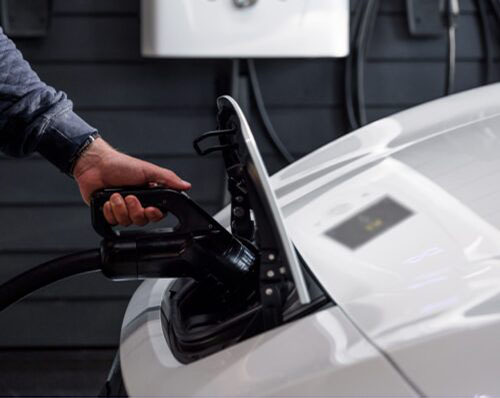Modern electric and hybrid vehicles are becoming the new norm in our society.
The Government of Canada is encouraging car manufacturers to increase their electric and hybrid vehicle production. They require that 20% of all new vehicles be zero emission by 2026, and 100% by 2035.
Ontarians are getting on board with this directive. They’re making the switch to electric vehicles and taking advantage of the incentives provided by the government to do so.
In the third quarter of 2022, 11,017 zero-emission vehicles were registered – an increase of 113.4% over last year.
This rise in modern vehicles means there are new hazards to be aware of in your parking structure.
New challenges are facing the fire protection design of your building and you must ensure you are compliant with the current standards.
The Challenges of Electric Vehicles in Fires
Electric vehicles are a unique challenge because the lithium-ion batteries inside them fail and burn much differently than a traditional internal combustion engine (ICE).
When lithium batteries fail they go through a process called Thermal Runaway. This is when a single cell produces heat, oxygen, and flammable and toxic gasses. It spreads to other cells and causes a rapid fire growth or explosion.
Fires ignited by lithium-ion batteries are more difficult to extinguish than gasoline or diesel. They require very large amounts of water, applied consistently for long periods of time, to fully contain the fire.
The battery also has a higher chance of reignition. This means firefighters must apply water to the exterior of the battery pack for hours and continuously monitor the temperature.
Although, less common than gasoline-powered vehicle fires, electric vehicles account for 337 fires globally between 2010 and 2022.
10% of these fires occurred in 2022, which aligns with the steady increase in electric vehicle purchases. 16% of the total fires occurred while the vehicle was connected to the charger and 23% occurred when parked in an underground enclosed space.
Fire Risks of Modern Vehicles
Electric vehicles are just part of the challenge when assessing the fire protection quality of your parking structure. The materials used to make vehicles are changing as well.
To meet government regulations for fuel efficiency and safety, many of the metal components of vehicles have been switched to durable plastics.
While these plastic parts make the vehicle lighter, safer, rust-resistant, and less expensive, they also are far more combustible.
Presently, three types of plastics form the basis of vehicle composition: Polypropylene (PP), Polyurethane (PU), and Polyvinyl Chloride (PVC).
Another change in vehicle composition is the increase of plastic fuel tanks that are now used in over 85% of vehicles.
Using High-density Polyethylene plastic instead of a non-flammable metal could result in an earlier release of fuel in a fire.
During a fire, a plastic fuel tank melts and leaks fuel, which then ignites and runs underneath neighbouring vehicles. This causes the fuel tanks of those vehicles to melt, creating a rapid fire spread in a short time.
Similar to examples we’ve seen of how fast synthetic household materials ignite, the same is true for vehicles. Plastic parts are easily ignited, fast-burning, and have a rapid fire spread to neighbouring vehicles.
A striking example of the highly combustible nature of the modern vehicle can be seen in a parking structure fire in Liverpool, England in 2017.
A fire that started in one vehicle spread to the entire structure. Within 2 hours, the parking garage and nearly 1,200 vehicles were fully involved.
The investigation found the parking structure was in perfect condition and fully compliant with UK fire protection standards.
The downfall was that the building was not modified to meet the current hazards of modern vehicle components.
Fire Risks in Parking Structure Design
The designs of parking structures are optimized to accommodate as many vehicles as possible. With more vehicles on the road, buildings are utilizing vehicle stacking systems and minimizing the space between vehicles in order to increase their capacity.
Having so many vehicles parked in close proximity can lead to rapid fire spread and increased difficulty in extinguishing and containing the fire.
Even in open parking structures – requiring a set minimum of ventilation on at least two sides – there are fire risks. While the open sides provide ventilation, they could also provide fuel to the fire by constantly giving access to fresh air. Strong gusts of wind could also increase fire spread.
In the 2017 Liverpool fire, the parking structure was open, but the ventilation on several sides was largely blocked by plastic advertisement posters.
Fire Codes for Modern Parking Structures
In light of the devastating parking structure fires that have happened in recent years, the National Fire Protection Association (NFPA) has updated the codes pertaining to these buildings.
NFPA 88A, Standard for Parking Structures (2023)
NFPA 13, Standard for Installation of Sprinkler Systems (2022)
NFPA 70Ⓡ, National Electrical CodeⓇ (2023)
New to NFPA 88A in 2023 (6.4.1) is the requirement that automatic sprinkler systems must be installed in all parking structures in accordance with NFPA 13.
There have also been additions to include electric vehicle charging equipment (7.1.5, 7.1.6, 7.1.7, 7.1.8). Any EV chargers installed need to comply with NFPA 70 and be in accordance with UL standards 2202, 2594, and 2750. UL (Underwriters Laboratories) conducts rigorous tests and sets regulations surrounding the electrical components and safety of the charging systems.
While reading NFPA 88A, ensure your parking structure is compliant with NFPA 220. This requires your building to be constructed using non-combustible materials. This is a concern because of the intense heat created by electric vehicle fires. If not properly constructed, there is a risk of the floor eroding and spreading the fire to vehicles below.
NFPA 13 has updated its classification of a parking structure from an Ordinary Hazard Group 1 to an Ordinary Hazard Group 2 (4.3.3.2). This increases the design density of sprinkler systems by 33% and the required gallons per minute to control the fire is now 0.2 over 1,500 square feet (0.2gpm/ft²).
NFPA 70 outlines how to protect people and property from electrical hazards. This code requires EV supply equipment (chargers) to have a service load of 7,200 watts or the nameplate rating of the equipment, whichever is larger (Article 220).
NFPA 70 also contains many other requirements for the charging stations in Article 625. Including listing the EV charging equipment, having the means to disconnect from the station, and the minimum distance from the ground a charging coupling must be.
What Can You Do To Protect Your Building?
To keep your building fully compliant with the revised codes, start by familiarizing yourself with the updates that affect your structure.
If you have EV chargers in your building do they meet the requirements set out by NFPA 70?
Does each charging station meet the UL standards?
If you have sprinkler systems, are they in compliance with the new code in NFPA 13?
Do the sprinklers have an adequate flow rate of 0.2 gpm/ft²?
Do you need to install sprinklers in your parking structure in accordance with NFPA 88A?
Your top priority is protecting the people and property in your building.
Studies have shown that the most effective way to contain and extinguish fires caused by modern and electric vehicles lies in the fire protection design of your structure.
The best way to ensure all these standards are met is to have a consultation with a Fire and Life Safety Technician. They’ll walk you through your structure and explain the updates that need to be made.
Contact us today to discuss your building.

